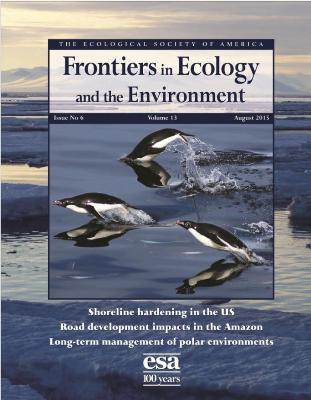Aug 7 2015
As we expand our coastal cities and armor the coast against the ravages of the sea, we lose the resiliency of the coastlines' natural defenses. Rachel Gittman and colleagues at the University of North Carolina, NOAA, and the US Coast Guard report in the August issue of ESA Frontiers that sea walls, bulkheads, breakwaters, and the like put in place to protect coastal communities harden 14 percent (22,842 km) of the tidal shoreline of the United States.
But this conservative 14 percent hides a concentration of coastal development along soft marshy estuaries, lagoons, and tidal rivers; remote rocky coasts are less likely to be bolstered with artificial structures.
 Cover picture: Although climate change poses the largest anthropogenic threat to the Arctic and Antarctic, other impacts -- including pollution, fisheries overharvesting, and invasive species -- must not be overlooked. Applying lessons learned from ecosystem management at both poles may help to mitigate regional environmental risks and conserve species, such as the Adélie penguin (Pygoscelis adeliae).
Cover picture: Although climate change poses the largest anthropogenic threat to the Arctic and Antarctic, other impacts -- including pollution, fisheries overharvesting, and invasive species -- must not be overlooked. Applying lessons learned from ecosystem management at both poles may help to mitigate regional environmental risks and conserve species, such as the Adélie penguin (Pygoscelis adeliae).
Gittman and coauthors Danielle Keller and Joel Fodrie will present research related to this report on shoreline habitat, hardening, and the ecosystem services trade-offs of different shoreline conditions at the upcoming 100th Annual Meeting of the Ecological Society of America in Baltimore, Md. on August 9-14.
- Rachel K. Gittman, OOS 77-5 The living shoreline approach as an alternative to shoreline hardening: Implications for the ecology and ecosystem service delivery of salt marshes. Thursday, August 13, 2015: 2:50 PM, room 329, Baltimore Convention Center
- Danielle A. Keller, COS 7-9 Landscape setting affects the structure and function of oyster reefs. Monday, August 10, 2015: 4:20 PM, room 321, Baltimore Convention Center
- F. Joel Fodrie. COS 7-7 Landscape context effects the ecosystem-service delivery of temperate biogenic reefs. Monday, August 10, 2015: 3:40 PM, room 321, Baltimore Convention Center
The ecological vibrancy of wetland habitats is valued by birders, hunters, recreational anglers, and commercial fisheries managers. Coastal wetlands succor birds, fish, and crustaceans, filter outflowing pollution, and naturally buffer the coast against storm surge and erosion. But natural dunes and salt marshes also absorb the energy of storms. Examples of natural dunes and salt marshes emerging from severe storms with little to no damage, while nearby bulkheads took a battering, suggest that storm surge protection and habitat protection need not be at odds.
Nearly a third of the shoreline in the contiguous United States could be hardened by the end of the twenty-first century if the rate of shoreline hardening observed over the last century continues. On sheltered coasts, fortification of shorelines correlates more strongly with high housing density and GDP than with wave height or frequent storms. The authors project that growing populations will direct most new hardening to the US' south Atlantic and Gulf coasts, which encompass greater that 50 percent of the remaining salt marshes and 100 percent of the mangrove forests in the US. The authors argue for the incorporation of green infrastructure into coastal protections as managers plan for the next century of growing cities and rising sea levels.
- Engineering away our natural defenses: an analysis of shoreline hardening in the US (2015) Rachel K Gittman, F Joel Fodrie, Alyssa M Popowich, Danielle A Keller, John F Bruno, Carolyn A Currin, Charles H Peterson, and Michael F Piehler. Frontiers in Ecology and the Environment, 13:6, 301-307.
Also in the August issue of ESA Frontiers:
Cold lessons
Profoundly different in topography, ecology, and social history, the Arctic and Antarctic have very similar vulnerabilities to climate change. Climate change exacerbates problems of pollution, over-fishing, and invasive species at both poles. Joseph Bennett and colleagues describe this perfect storm of threats and lessons in cooperation from the polar regions.
- Polar lessons learned: long-term management based on shared threats in Arctic and Antarctic environments (2015) Joseph R Bennett, Justine D Shaw, Aleks Terauds, John P Smol, Rien Aerts, Dana M Bergstrom, Jules M Blais, William WL Cheung, Steven L Chown, Mary-Anne Lea, Uffe N Nielsen, Daniel Pauly, Kenneth J Reimer, Martin J Riddle, Ian Snape, Jonathan S Stark, Vivitskaia J Tulloch, and Hugh P Possingham. Frontiers in Ecology and the Environment 13:6, 316-324.
Adaptive legalese
Environmental law has not kept up with the last 40 years of ecological discovery. The law struggles, in particular, to address dynamic ecosystems and adapt to the kind of global scale change ecologists expect in the coming century. The very different approaches to uncertainty and complexity in science and law bedevil the application of environmental research to environmental law. Lawyers and ecologists collaborate in this Concepts & Questions article by Olivia Odom Green and colleagues to recommend an adaptive governance approach to bridging the gap.
- Barriers and bridges to the integration of social-ecological resilience and law (2015) Olivia Odom Green, Ahjond S Garmestani, Craig R Allen, Lance H Gunderson, JB Ruhl, Craig A Arnold, Nicholas AJ Graham, Barbara Cosens, David G Angeler, Brian C Chaffin, and CS Holling. Frontiers in Ecology and the Environment 13:6, 332-337.